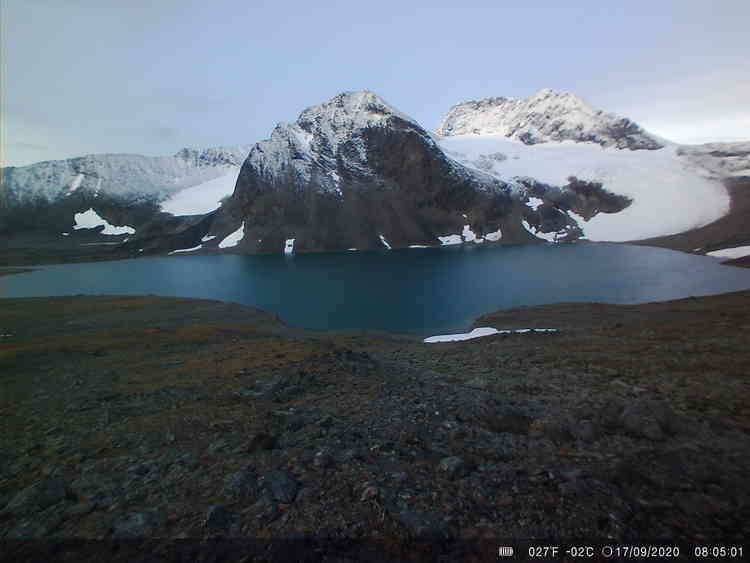Nina Kirchner, Annika Granebeck, Daniella Lillieroth Charalambous
This dataset contains images of Lake Tarfala taken daytime every 2 hours during the period from 17 to 26 October 2020. During this period, the surface of Lake Tarfala transitions from being ice-free to ice-covered, an event referred to as "ice-on".
The dataset can be used to observe the ice-on event and to assign a date (or, rather, a time interval) to it. Knowledge of lake ice phenology, i.e. seasonal formation and loss of the lacustrine ice cover, is of importance since the timing of ice-on impacts lake processes such as stratification and vertical mixing.
The pictures were acquired using a camera positioned on the mountain flank along Lake Tarfala’s north-eastern shore, at 1220 m above sea level. In total, there are 262 images.
Download data

Scientific highlights
This dataset allows to assign a precise date to the ice-on event at Lake Tarfala in autumn 2020. Defining ice-on as the first occasion after the ice-free summer season on which the lake becomes completely ice-covered and remains so for the rest of the winter, it was attained on 21 October 2020.
Precise knowledge of the ice-on date can be used to:
- Assist in understanding lake mixing processes.
- Better constrain numerical models computing ice-on.
- Provide a complement to ice-on dates derived from satellite imagery, which is notoriously difficult in polar alpine environments due to persistent cloud cover and long polar nights.
- Lend support to alternative definitions of ice-on.
- Contribute to knowledge of lake ice phenology in high altitude Arctic environments under current climate change.
Some notable events in the time-lapse imagery of the establishing lake ice cover include:
Pre-ice-on
- 19 September: Winds over lake surface illustrating typical conditions for lacustrine vertical mixing (at 12:05, 14:05). Wind data recorded by the SMHI weather station Tarfala A (67.9124° N, 18.6101° E) indicates moderate to fresh breeze conditions on the Beaufort scale during this time interval, with wind speeds between 6.8 to 8.4 m/s. Tarfala A is located in close proximity to Tarfala Research Station, ~1 km from Lake Tarfala.
- 27 September: First occasion of thin ice layer formation on lake surface (most visible at 14:05). Repeated occurrences of the phenomenon can be seen along the northern shoreline (right margin of picture, e.g. 28 September at 10:05) as well as in the southern (left margin of picture, e.g. 1 October at 14:05 and 3 October at 14:05) and central parts of the lake (e.g. 4 October at 10:05 and 11 October at 14:05).
- 29 September: Onset of drift of large section of thin ice in the central parts of the lake (at 06:05 until 18:05).
- 13 October: Formation of patterns in the northern lake section (at 10:05, 12:05), also visible on another occasion with similar spatial distribution (20 October, at 10:05, 12:05).
- 14 October: Drift of larger floes into southeastern lake corner (at 08:05 until 16:05).
Ice-on
- 21 October: First occasion of clearly identifiable ice cover across the entire lake surface, subsequently snow covered (at 10:05 and forward).
- 23 – 25 October: Appearance of large crack-like features on ice surface and along shorelines combined with patterning of snow cover on frozen lake surface (e.g. 23 October, at 16:05).
- 26 October: Thickening of ice cover and establishment of continous overlying snow cover.
Note that the camera produces black-white images under certain light conditions, such as during dusk and dawn and under some low-visibility weather conditions.
Citation
Nina Kirchner, Annika Granebeck, Daniella Lillieroth Charalambous (2023) Time lapse imagery of the ice-on event at Lake Tarfala, Kebnekaise Mountains, northern Sweden, autumn 2020. Dataset version 1. Bolin Centre Database. https://doi.org/10.17043/tarfala-kirchner-2023-ice-on-2020-1
Data description
The dataset consists of image files (JPG) of Lake Tarfala, with the date and time (Swedish daylight saving time, UTC+2 until 25 October and thereafter Swedish standard time, UTC+1) included in each photo.
The pictures were acquired using a camera positioned on the mountain flank along Lake Tarfala’s north-eastern shore, at ~67.9° N, 18.6° E, at 1220 m above sea level.
The data were collected using a SiFar Willfine Trail Camera 4.0CG. The camera elevation is 1.8 m above ground. Each JPG file has a size of ~1 MB. The total size of the dataset is ~235 MB.
During a few short periods, fog, snow and/or rain obscures the view of the lake. Due to shorter periods of daylight during autumn, the number of dark images between dusk and dawn successively increased. These are therefore excluded from the dataset.
Comments
The support of our co-workers on the Arctic Avenue activity Lake thermal and mixing dynamics under changing climate (J. Weckström, K. Weckström, A. Korhola, and F. Schenk) is gratefully acknowledged.
GCMD science keywords
Earth science > Cryosphere > Snow/ice > Lake ice
GCMD location
Continent > Europe > Northern Europe > Scandinavia > Sweden
Project
The data were collected as part of a project within the Arctic Avenue Spearhead Research project between Stockholm University and the University of Helsinki, Finland, running between 2019 and 2022. It has contributed to this work through activity Lake thermal and mixing dynamics under changing climate.
Publisher
Bolin Centre Database
DOI
10.17043/tarfala-kirchner-2023-ice-on-2020-1
Published
2023-05-09 16:12:44
